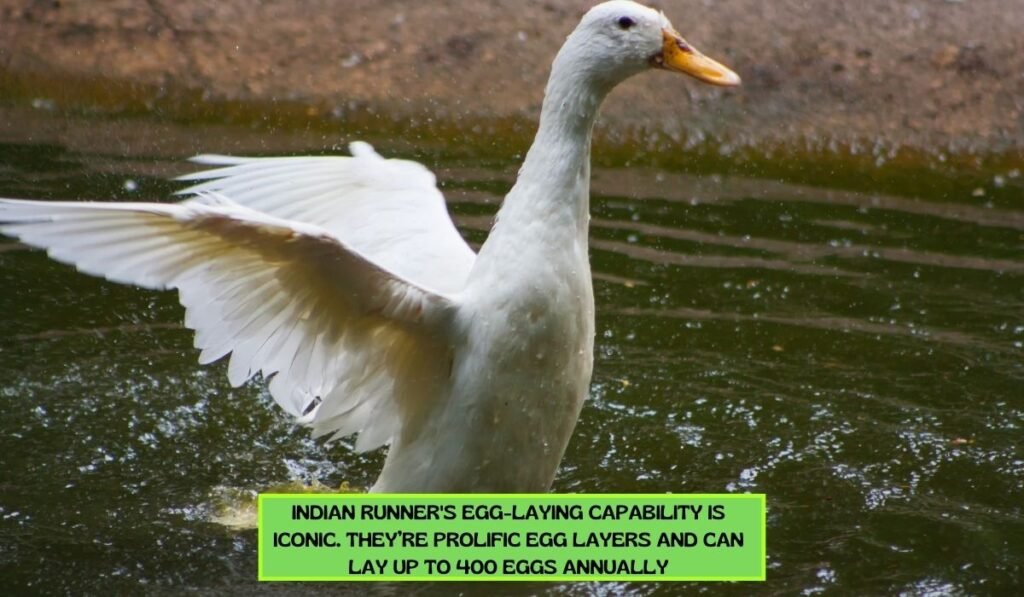
Indian Runner Ducks are the most commonly crossbred ducks in the world. One exciting thing is it has the tag Indian with its name, but it doesn’t originate from India! Sounds good, right?
Alright, where does the Indian runner duck come from? They originally come from Southeast Asian countries like Malaysia and Indonesia. Indian Runner ducks are one-of-a-kind for their distinct leg positioning and appearance. Despite being birds, they can’t fly; Instead, they run. However, Europeans discovered their commercial potential in the late 19th century.
I’ll come up with every other potential thing that can be brought up while talking about Indian Runner ducks. So, just keep on reading this article.
Table of Contents
The Indian Runner Duck In A Nutshell

Indian runners are mainly a unique and domesticated subspecies of Mallard ducks. Let’s have a look at all of their introductory aspects.
| Characteristic | Description |
|---|---|
| Scientific Name | Domesticated subspecies of mallard (Anas platyrhynchos) |
| Origin | Southeast Asia, specifically Indonesia, and Malaysia |
| Bird Order | Anseriformes |
| Family | Anatidae |
| Subspecies | Domesticated breed, no recognized subspecies |
| Varieties | Various color varieties exist, including white, fawn, and black |
| Purpose | Egg-laying breed known for prolific egg production |
| Distribution | Worldwide, due to domestication and trade |
| Reproduction | Egg-laying breed, known for prolific egg production |
Origin of Indian Runners: Southeast Asia, Mainly
It’s basically the South Asian region from where Indian Runners started to spread throughout the world. It was anciently found in Indonesia and Malaysia. The history of Indian Runner is intertwined with human civilizations. They have been domesticated for over a hundred years, at least, if not a thousand years!
Dutch East Indies Company Sailors in 1600 Introduced Indian Runners
They were basically well-known for their egg production. They were found here and there in the ports and urban areas. In those areas, eggs and birds were sold. These ducks were stored as food in the sailing shops produced by the historical Dutch East Indies Company in 1600.
Europeans Marked Indian Runner In the Middle of the 19th Century.
However, the Europeans notably marked Indian runners in the middle of the 19th century, according to research performed by an organization. They also claim ducks that are called the Indian Runners aren’t an Indian Duck Breed.
The Indian Runners are featured in some of the Paintings art by the Dutch Masters. It is determined by their body size and color that defines Indian Runner as a separate breed.
Physical Appearance of Indian Runners

When I talk about appearance, I must say Indian runners have a distinct and upright appearance. Here’s how their physical appearance is.
Body Shape:
The cylindrical body shape and unique leg positioning of Indian Runners are something to be amazed at. Their unique legs and movements usually remind me of a penguin.
Their legs are positioned farther back on their bodies. This unique body shape and leg placement enable them to run gracefully instead of waddling like most ducks.
Head and Tail:
Their Heads are characterized by wedge-shaped skulls with extremely straight bills. Their eyes are high on their head, giving them a keen and alert expression. In addition, their tail is much more shaped and compact compared to some other duck species.
Measurement and Weight:
They can measure up to 26 inches from the head crown to the tail. However, Indian Runner ducks can be weighed from three to five pounds. Depending on their gender, their weight may vary.
Colors:
What makes Indian Runners more attractive is their color. A more charming fact is their wide variety of colors. They come in various colors, including chocolate, black, white, blue, light brown, dark brown, and even a brownish shade of green! These vibrant colors add to their visual appeal, making them fascinating feathered creatures!
Reproduction of Indian Runners
Well, Indian Runners are huge in terms of production and egg-laying capability—the Runner moms like having babies in the spring or summer. It means in a weather that is too hot or too cold.
The mommy ducks may lay one egg every day until she has a bunch of them. Once she has got a complete set, she starts hatching, which may be for 28 days. However, they may start hatching while there are a couple of eggs.
Although farmers say Indian runner egg production is vast. They usually do not hatch them. Breeders do place the eggs under a broody duck to hatch them. The body heat of the ducks helps the eggs develop, and eventually, these hatch into ducklings. It’s a natural process that happens without any complicated stuff.
Egg Production or Meat Production?

I’ve said it earlier: Indian runners are on a different level when discussing egg production. From ancient times to today, when Indian runners are considered the most crossly breed duck around the world, they still top the chart of ducks that lay the most eggs.
However, let’s compare the purposes and create a verdict for which purpose Indian Runners serve the best.
Egg Production is Huge and Cost-effective
Indian Runner’s egg-laying capability is iconic. They’re prolific egg layers and can lay up to 400 eggs annually. So, for a consistent supply of eggs, no matter for business or for just taking eggs, Indian Runners are one of the best.
The eggs are appealing as well. These are big compared to the other egg-laying duck breeds. On top of that, Indian Runner ducks are great foragers and can find food for themselves. That means food costs aren’t high for them.
They are also less prone to obesity, which can affect egg production. They’re suitable for egg production because of high egg-laying frequency, size, quality, and cost efficiency.
Here’s my list of the top 10 ducks around the world that are best for egg production.
| Duck Breed | Approximate Eggs Per Year |
|---|---|
| Khaki Campbell | 250-340 |
| Indian Runner | 250-350 |
| Golden 300 Hybrid | 200 – 300 |
| White Layer | 200-300 |
| Ancona | 210 – 280 |
| Welsh Harlequin | 150 – 200 |
| Ancona | 210 – 280 |
| Buff Orpington | 150 – 220 |
| Blue Swedish | 150 – 180 |
| Cayuga | 100-150 |
Indian Runners Are Below Average for Meat Production
Why I’m calling it average for meat production is the size. Indian Runners are comparatively small in size and don’t make good meat production. There are some popular ducks that are good for meat production, such as Pekin and Muscovy ducks.
In addition, their muscle isn’t rapidly developed. So, Time efficiency is questionable here since you want to make money.
To sum it up,
- Indian runners are great at laying eggs
- They produce huge egg production
- The size is big and appealing
- They’re great foragers as well
- Which means cost efficiency is high.
So, choosing them over other duck breeds for egg production is cool, but while you want to eat them, there are better options than Indian Runners.
Recommended Read: 5 Best Duck Breeds for Eggs!
Indian Runners and Their Dietary Preference

They have a varied diet that includes poultry bird feed. They’re great foragers as well. While they’re in your backyard settings or in a farming setup, do not just worry. Their diet isn’t complex, and they do not require much dietary attention either. Here’s what I want you to let me tell about their diet:
- Poultry Bird Feed is Fine: Standard poultry bird feed is fine as it is a mixture of grains, pallets, and seeds. There is no problem with feeding poultry bird feed to Indian Runners. Instead, these bring several health benefits due to being rich with essential nutrients to grow and develop faster.
- Greens: Do consider greens in the list of their diet importantly. These greens are essential for additional minerals and vitamins, such as lettuce, duckweed, and grass.
- Let Them Forage: Indian Runners are great foragers. They roam around the backyard and find food for them, such as insects, small fishes in the pond, water plants, and all that. The most beneficial thing is that they eat insects and bugs in their diet and, in the meantime, contribute to pest control!
However, here’s a note – their specific dietary needs and requirements may vary slightly. It’s always a good idea to consult with a vet or poultry expert for personalized advice on feeding Indian Runner ducks based on their age, health, and specific needs.
Do Indian Runners Make Good Pet Ducks?
In short, the answer is positive: Indian Runner ducks can make good pets. They lay lots of eggs and eat pests. Plus, they’re fun to watch. But there are some other factors to consider as well.
How you pet an animal or a bird may vary from person to person. The discussion below is a pros and cons analysis for making an Indian Runner a pet duck.
The pros of keeping Indian Runner ducks as pets are as follows
- Excellent Egg Production
- Pest Control. Indian Runners are particularly famous for controlling pests. Here’s a video featuring an Indian Runner squad for controlling pests in South Africa:
- They aren’t prone to so many illnesses. A hardy breed, to be more specific.
- Attractive appearance and is fun to watch.
Meanwhile, the cons can be like this:
- Like all other ducks, they’re messy.
- They require space for them to roam around. So, you may need to manage space for them. If you’re from some urban areas, this may not be an ideal place for them.
- Most importantly, Indian Runners, like other pet ducks, require specific care, including creating predator protection and being specific about food and access to water for swimming.
So, the final verdict is that Indian Runner ducks are great as pets only if you take them in a backyard setting and let them forage and be themselves. But if you literally want them to imprint on you, this is a different case. It isn’t widely suggested, and therefore, it’s not an ideal pick as a pet.
However, you may read our article on imprinted ducks here.
Can I Raise Indian Runners For Commercial Purposes? Of Course Yes!
Absolutely. Indian Runners can be raised for commercial purposes. Tell me, why not? Laying approximately 400 eggs isn’t an easy deal.
These eggs are big in size, have a rich flavor, and are popular, especially in the culinary industry.
So, you have your answer. Now let’s have a look at the other considerations.
- Make sure your area demands duck eggs. Your cost factors should be based on housing, food, labor, and marketing. Anyway, understand briefly what law enforcement says about raising ducks in your state.
- Find buyers wisely. Local restaurants, bakeries, and food stores can be considered. You’ll also need to think about pricing and how to compete with the others in the market.
- Finally, taking good care of your ducks is a must. They need the proper diet, clean water, suitable housing, and vet checkups on a timely basis.
Related Readings:
- Some Untold Facts About Australian Spotted Duck
- The Finest French Bird: Rouen Duck Breed
- About Egg Laying Khaki Campbell Duck
FAQs
I guess you’ve got all your answers. Want to learn something more? Have your eyes here.
Q: Do Indian Runners Fly?
No. Indian Runners don’t fly. They just roam and run while other duck breeds fly. Mainly, their unique leg positions allow them to run.
Q: How much space do Indian Runners require to Sleep?
For sleep, around 4 feet is fine for an Indian Runner duck. They do not require any specific living space as well. If you raise them for commercial purposes, you need to ensure dry bedding, clean water, and poultry bird feed.
Q: Aren’t Indian Runner ducks noisy?
Indian runners are quite silent. Interestingly, Indian Runner ducks quack more often than the other duck breeds. But they aren’t loud. So, they quack against each other more often, but that is not too loud and won’t create any disturbance at all.
Q: Do Indian Runner Ducks need water while breeding?
No. However, ducks, in general, do require water for breeding. But Indian Runners are unique. They do not require water to breed.
Bottom Line
The Indian Runner ducks are stunning. They’re table toppers of the list of egg-laying ducks, which don’t require high cost for feeding and a particular living place as well. They can make good pets in a backyard setting as well.
If you want them to do business, keep a couple of things in mind. Take proper care of them, feed them according to their requirement, and create predator protection. However, I don’t suggest you make your duck imprint on you. Because ducks aren’t suitable for such things.
Sources and References:
- https://www.oregonzoo.org/discover/animals/indian-runner-duck
- https://tile.loc.gov/storage-services/public/gdcmassbookdig/indianrunnerduck00vale/indianrunnerduck00vale.pdf
- https://www.indiarunner.com/runner-diet-plan.php






